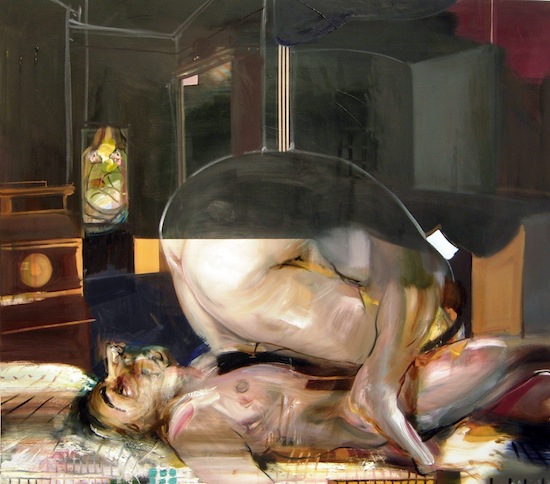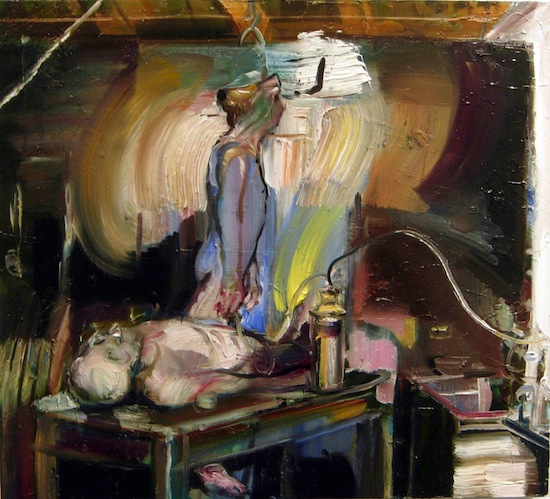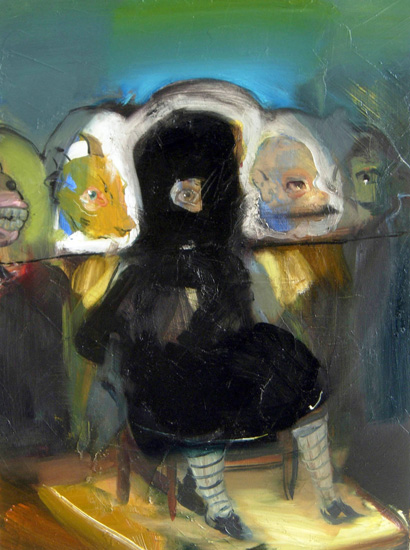What is the role of painting today? The power of illusion in painting is magical but limited. Installation artists have the advantage of using their galleries as an element, or even the subject, of their work. Thomas Hirschhorn turned his gallery into the skewed interior of the sunken cruise ship Concordia. Andra Ursuta harnessed her gallery as a literal element in her work when she rammed a two-ton Romanian wagon into through the front window and crushed the back wall and gallery office. How can a two-dimensional painting summon the same evocative response in the viewer?
But painting's limits are also integral to its power. The limits of its structure - paint on canvas or wood - can make it feel like a safe and easy mode of expression. But the centuries of development of painting's visual language has led to the development of recognized conventions that can be grappled with and manipulated. A painter today can communicate intimately with the audience by accessing realms of information through imagery, symbolism, style, and visual quotation.
Natalie Frank is a master of utilizing painting to the fullest extent, exploring the human condition through themes such as power, violence, sex, and transfiguration. In her current show, "The Governed and the Governors," Frank's paint is so thick, her expressionist distortions of the human figure exceed Francis Bacon at his most satanic. The visceral - sometimes disturbing - quality of her work is reminiscent in some ways of the distinguished and controversial filmmaker Pier Paolo Pasolini, who sent viewers running from theaters with the gruesome exploration of sadism in his film 120 Days of Sodom.
Frank underplays the power of her paintings, saying "they're as playful as they are dangerous, because it's impossible to have sincere or total belief in illusions. The holes have been poked through it. It's an ambivalence." Her process involves working hard on recognizable images, then painting back over them, negating them. She says, "If I want to take black and destroy a fourth of the picture in five seconds, I'm going to do that." Though she feels conflicted about painting representationally, she enjoys it in combination with abstract elements such as cartoony lines or broad swathes of paint.
For me, Frank's negation of images with abstract elements confirms - and thus increases - their power. It works in the same way as a conceptual artist who destroys her gallery, thus making it essential for the meaning of the work. The strokes of paint that break the illusion and pull your eye back to the surface of the painting, somehow pull her illusions along with them. Frank's violent negation of bodies allows her to palpably explore their roles and relationships to each other and their interplay with myths, allegories, fantasies, and history.

Image courtesy Natalie Frank
"Under and Through" This painting depicts the three stages of women. First, young lovers who are part animal decay into abstraction. Second, there's a woman with her hand in a man's pants, who has been partially obliterated by abstract stripes. Third, in the distance there is a deathly specter of a woman, gazing back on the young lovers. Says Frank, "It's my version of a Titian at the Louvre, which portrays the three stages of man."

Image courtesy Natalie Frank
"One, Two" A reclining woman has a figure coming out of her, or a figure going forwards on top of her in a sexual act. Her arm is like a haunch, making it like a nightmarish or ritualistic activity. The black scrim comes down and then is painted into, functioning as both containment and division. This painting was inspired in part by the photographs by the crime photographer Alphonse Bertillon.

Image courtesy Natalie Frank
"Autopsy" This depicts a transfiguration where one person morphs out of another, whether dead or alive. Says Frank, "This idea has been recycled through time from artist to artist, even from novels into visual arts into opera and music. It's all related."

Image courtesy Natalie Frank
"Trying on Heads" The woman with the black cloak and striped stockings and charts is trying on heads to see which one fits her. There's an ape and a ram and a monkey-looking figures among others. The figure's hands are tied behind her back. " I wanted her to be somewhat helpless amidst the helpless and the absurd," says Frank, "but in the process of transfiguration or transformation."
Painting today may be less dangerous than in previous eras (after all, it's YouTube videos that are sparking riots in the Middle East). But it's still an expression of desires, and danger is a crucial part of the mix. Frank says, "I have utter freedom in the studio, freedom I don't give myself in life. I'm probably more prim in life than I am in the studio, and it's nice to have a place where I can just do whatever I want and not be accountable to anyone." And what is Frank's take on people who say they feel threatened by her work, missing its playful aspect? She laughs, she says, and tells them "thank you."
Visit her show, "The Governors and the Governed," at Fredericks Freiser Gallery, October 4 through November 2, 2012. Find out more about her inspirations and studio practice in the video below.